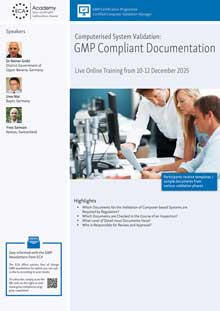FDA READINESS: WHAT EXACTLY IS THAT?
Many pharmaceutical companies strive for an often-heard "FDA Readiness" - that is to say to be prepared for the FDA. But what exactly does this term mean? And does everybody mean the same? Usually this kind of readiness is equated with an all-encompassing quality objective: all pharmaceutical quality systems in the operational units must be on such a high level that an inspection by the US-FDA can take place without much preparation. This is in itself a noble ambition. For pharmaceutical companies in the United States it is quite understandable, though, as they are inspected by the FDA regularly without prior notice. There one can find inherent functions and partly even entire groups doing nothing else. This "Inspection Administration" is located in the units ensuring quality (e.g. in the Quality Control Unit or in Quality Assurance), and they are always ready to receive inspectors and to lead them through an inspection. In addition, they try to achieve and maintain a uniformly high cGMP level in cooperation with all entities involved. Outside the United States, this form of organisation does virtually not exist. Although companies also strive for establishing a consistently high cGMP level, they still prepare individually for an FDA inspection. This is mainly because of the fact that inspections are announced. Then, quite frequently companies make a lot of effort to specifically prepare for exactly this inspection.
Both approaches have in common that they question and try to understand cGMP systems in the enterprise - with the goal to identify potential weak points and compliance risks and to get them under control through effective management reviews and CAPA processes. Ideally, this results in a continuous quality improvement and related systems.
And when is one ready for the FDA inspection? The following questions may be helpful in the assessment:
- Did you examine your entire processes with a critical and unbiased eye, as the FDA would do?
- This includes the entire process chain with all areas involved - including, e.g., technology and microbiology. - Did you identify all possible internal and external compliance risks, and were they evaluated and addressed?
- Recognise (and fix) your weak points before the FDA does. - Do you know the current inspection trends and possible areas that specifically relate to your product?
- Inform yourself as much as possible about trends, but also about your inspector. - Did you involve potential customers, partners and service providers in your information and evaluation?
- Especially in pre-approval inspections they can quickly become part of the inspection - Did you inform and prepare all employees involved? Are all roles clearly defined?
- It is important to know who does what. Get the management to be involved. - Are you sure that all your employees can competently answer the questions of the inspectors and can provide clear information about the processes and documentation?
- Train your staff. - Did you establish procedures for how you handle the inspection and how to answer the questions of the inspectors?
- The management of an inspection is very important. - Do you know how to make documents available efficiently?
Translate important documents in advance. Check the efficiency of your document management system. - Did you develop strategies to discuss potential compliance weak points during the inspection?
- Do not try to downplay. Admit weaknesses and provide information on how you will tackle the problem and what you already initiated in this regard. - Do you know what is important in the aftermath of the inspection and how you formulate possible answers?
- When answering the forms (Form 483), inspection reports and the so-called warning letters there is a lot that can go wrong.

Recommendation
Tuesday, 3 February 2026 13.00 - 17.00 h
GMP for Excipients - Live Online Training
Author:
Wolfgang Schmitt
... is Operations Director and organises and conducts courses and conferences on behalf of the ECA Academy in the areas Quality Assurance, GMP and GDP.




